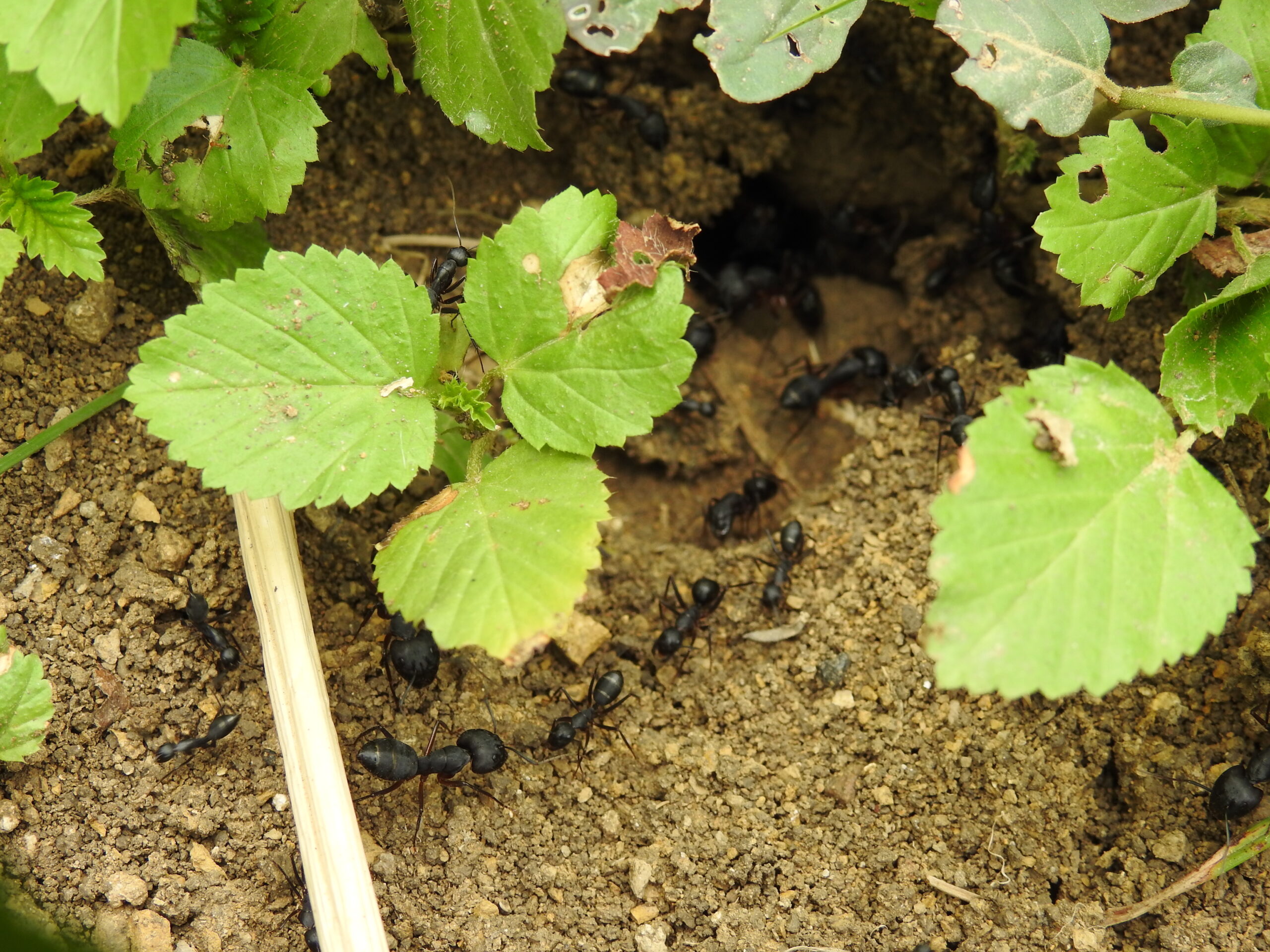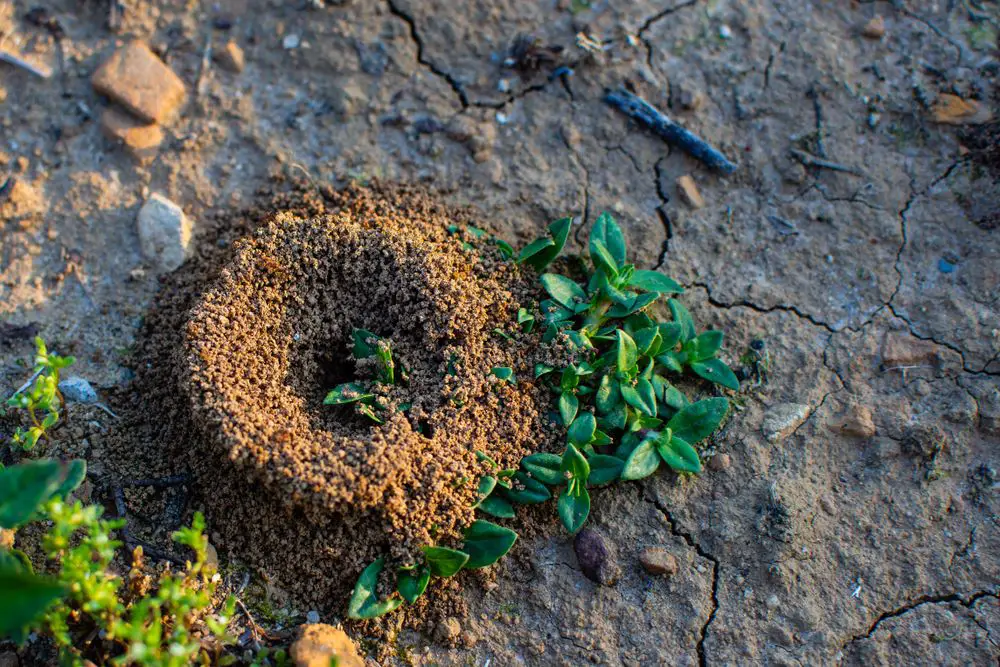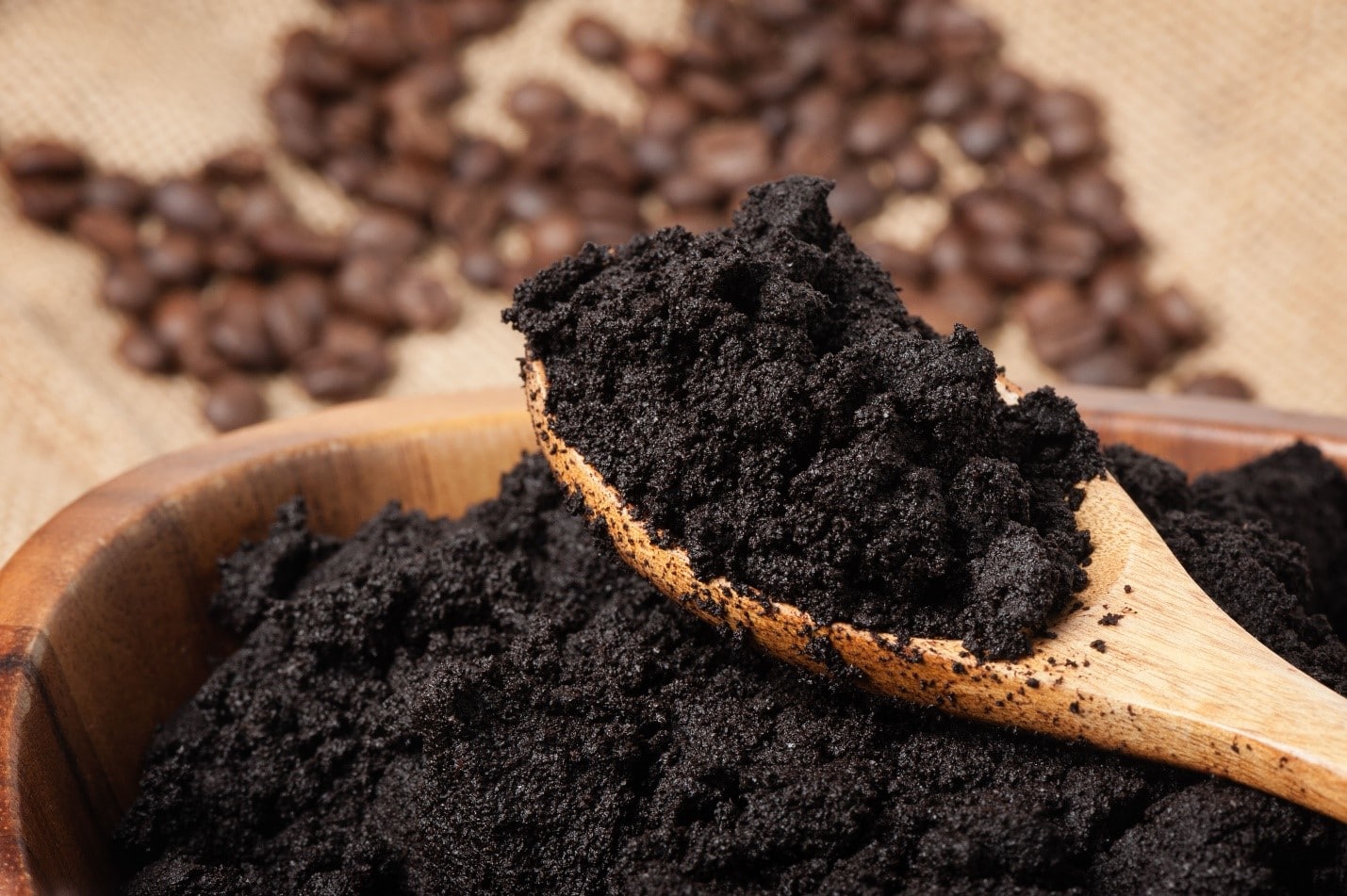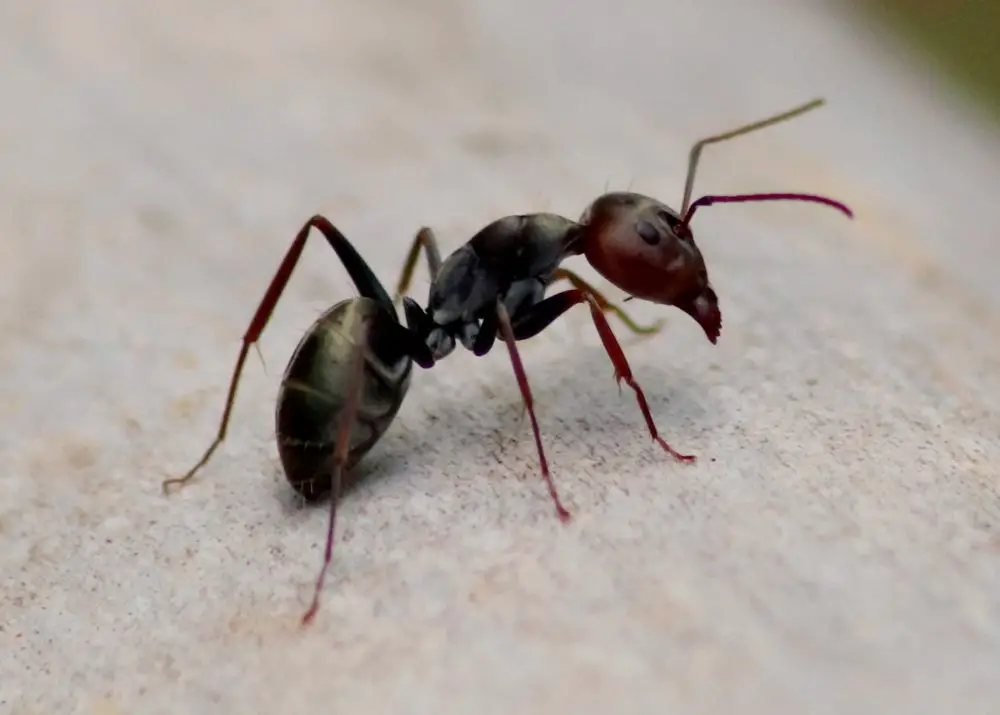Even though ants are tiny, this does not imply that they are weak in infestation control. Ants coexisted on the planet alongside dinosaurs such as the Tyrannosaurus rex, and they managed to escape a global extinction catastrophe.
To kill the ants in your home or grounds, you need to find their nest. Then, whatever method you decide to use, it’s essential that while destroying all the ants, you must kill the queen, or she could recreate another colony. Using homemade mixtures of natural ingredients, be methodical and patient, and you’ll quickly and safely.
How to Kill Ants in the Yard – Naturally and Easily
Black Garden Ant

Anthills are unsightly eyesores in yards, and the ants may make it difficult to eat outside. If you just have ants in a specific location, such as along your sidewalk, you can use:
Liquid Detergent and Glass Cleaner
Did you know that when ants walk, they leave behind them a scented pheromone trail?
This trail acts like a sort of map so other ants can follow and find them and also so they remember where they’ve been. Using this mix removes all the scents they left behind so the map is wiped out and they cannot remember how to re-enter your home.
Instructions for the mix:
1. Combine glass liquid detergent (dish soap) and glass cleaning spray in a clean spray bottle and gently mix.
2. Spray the concoction on areas where you’ve seen ants enter your home or where they group.
3. Wipe down the area, after spraying, leaving a light film.
4. Keep repeating the above stages as and when necessary.
NB: If there’s no glass cleaner to hand, just use soapy water (i.e. hand soap, dish detergent) which is also liable to kill the ant pheromone odour.
Instead of an outdoor pesticide, to treat that area specifically.
Other Insects Could Be Killed by Homemade Mixtures.
Oil Of Lemon Eucalyptus (OLE)
Despite their similar names, the oil of lemon eucalyptus (OLE) is different from lemon eucalyptus essential oil. OLE comes from the gum eucalyptus tree, which is native to Australia. It contains a chemical called p- Menthane-3,8-diol (PMD), which is an effective insect repellent.
PMD is classified as a biopesticide by the Environmental Protection Agency (EPA) and is considered safe to use.
You can find OLE at your local hardware and gardening store or online with instructions for use.
First and foremost, mow the lawn. Then spray the mixture across the entire lawn, including bushes and trees if you want to be extra thorough.
The best times to spray are early in the morning or late in the afternoon when the ants are most active.
Furthermore, spraying should be done on a quiet day to avoid drift. Treat your grass again if the ants are still constructing mounds six weeks after the first application of treatment (the insecticide works for up to six weeks).
You won’t be able to eradicate every ant in your yard (and you wouldn’t want to!), but spraying will destroy the majority of them and put an end to the annoyance of ant mounds.
Destroy Exterior Nests of Ants
If you regularly notice ants at the same spot on the siding, there is most likely an ant nest in the region.
The first step in getting rid of ants is to check for cracks or holes in the siding where ants are creeping in and out. The holes are frequently seen between bricks where mortar has crumbled away, underlap siding, or in cracks in stucco, among other places.
Once you’ve located the nest, or the region around the nest, using the boiling water technique to deal with the situation:
Pouring of Boiling Water
If you see ant holes near your house, pour boiling water into them. This method will immediately kill many of the ants inside. Small anthills could signify vast ant colonies beneath.
Open the nest with a rake and fill it with hot water (add liquid soap for extra killing power).
Because boiling water can harm flora, caution should be exercised when employing this approach on lawns.
The boiling water won’t be enough to destroy the whole colony. For this reason, be sure to treat every ant hole you see within your home’s proximity.
Open the nest with a rake and fill it with hot water (add liquid soap for extra killing power).
Because boiling water can harm flora, caution should be exercised when employing this approach on lawns.
Using White Vinegar
White vinegar is a low-priced and active way to kill and repel ants. It is also a natural cleaning agent.
Use a 1-to-1 vinegar/water mixture to clean hard surfaces, including floors and countertops, wherever ants are likely to be found.
Equal amounts of vinegar and water should be used.
To improve the killing effectiveness of the solution, add a few drops of liquid soap.
When you see ants, spray the mixture on them or clean them up with a paper towel.
Open the ant nest with a rake and pour the mixture inside. Vinegar has the potential to destroy plants, so exercise caution when applying it to lawns.
Ants smell the vinegar after it dries, but people don’t.
Using Water
Soak the nest for 15 to 30 minutes with water from a hose, ensuring the dirt is well saturated.
Because ants may live underwater for up to 24 hours, you may need to repeat the treatment roughly 22 to 23 hours later to confirm that the ants have been completely drowned in the first treatment.
Using Boric Acid
Make your liquid ant bait by combining three tablespoons of sugar or peanut butter with two teaspoons of boric acid crystals and 2 cups water in a blender until completely smooth and creamy.
To dissolve acid crystals, bring the pot to a boil for 6 minutes. Allow cooling before storing in a labeled container. Make a bait container out of a yogurt cup or some other container of your choice.
Make a few holes in it so that ants may crawl in and out of it. Place 2 to 3 teaspoons of the solution in the bait container and secure it with a lid or aluminum foil to prevent it from drying out. Place the container close to the ant nest.
How to Get Rid of Ants Indoors
A few ants in your home are an indication that there are many more in the surrounding area, which is a safe bet. House ants are the most frequent of the 25 ant species that often infest dwellings, and they are the most difficult to eradicate.
They’re generally less than an eighth of an inch long and are mostly a nuisance pest, not capable of inflicting damage or transmitting illnesses. Use these methods to keep ants under control indoors.
Using Baking Soda
Baking soda and powdered sugar should be mixed in equal amounts and placed in a small, lidded container or shallow container in the area where you’re observing ants.
An acidic substance in their stomachs is activated when ants eat baking soda, resulting in their death as a result. This bait can aid in the killing of ants in their colony.
Using Borax (Sodium Tetraborate)
This is different to Boric Acid although many people think it’s the same.
A colony-killing bait may be made by mixing the same amounts of Borax and corn syrup. Using a tiny piece of cardboard or index card, smear the mixture. Insects are attracted to corn syrup, and when they consume it, they are killed by the Borax.
Borax and boric acid are not the same chemical compound despite their similar-sounding name.
Both may be equally as effective at killing ants in the home.
It’s vital to keep borax away from pets and children as it could be very harmful.
To use borax, follow these steps:
1. Put on safety gloves.
2. Make a solution of 1/2 teaspoon borax, 8 teaspoons sugar, and 1 cup warm water.
3. Stir until the sugar and borax are dissolved.
4. Saturate cotton balls and place them around your home in areas where you commonly see ants.
5. After use, wash containers thoroughly or discard.
Find borax at your local hardware and gardening store or online.
Using Diatomaceous Earth – Silicon Dioxide
Diatomaceous Earth kills ants by causing them to become dehydrated. The ants who come in contact with it are affected, but the ants in the nest are not.
D.Earth is composed primarily of diatomaceous material (DE). Ant trails should be sprayed with food-grade DE.
Diatomaceous earth is a type of silica made of fossilized remains of aquatic organisms called diatoms (a type of plankton).
Diatomaceous earth isn’t a poison. It kills ants and other bugs by absorbing the oils in their skeletons, which dries them out. But since it’s an irritant, humans and animals must avoid breathing in diatomaceous earth or getting it on your skin.
You can purchase food-grade diatomaceous earth online. To use it to kill ants, follow package directions, or sprinkle the powder anywhere you see ants.
Using Castile Soap
A solution of 1/4 cup Castile liquid soap and 1 quart of water may be made into a spray. Upon contact with this spray, ants are killed. It is effective against scout ants, but it will not kill ants that have returned to the nest.
Understand the Ant’s Way of Life
Ants have a lot of stamina and are incredibly resilient. Despite this, it is feasible to clear your home of ants if you do not underestimate their might.
Whether you’re dealing with ants indoors or outdoors, it’s always preferable to eradicate the ant colony rather than merely repelling the insects.
Each ant colony might have hundreds or thousands of individuals, depending on its size. If left unchecked, ant colonies may swiftly grow in size, turning a little nuisance into a nightmare in no time.
An anthill on the lawn or the pavement is simple to see while you’re out in nature. The portion of the anthill that you can see is only the tip of the iceberg that is the ant colony.

Surface mounds are typically surrounded by colonies that reach 2′ to 3′ beneath the surface mound and 2′ to 4′ surrounding it. Because ants like to conceal themselves, it is difficult to locate their nests indoors – beneath floors, in walls, or behind cupboards.
Each ant colony comprises at least one queen and several worker ants. The colony will continue to exist as long as the queen is alive.
Whatever method you use to get rid of ants, keep in mind that you want to eliminate the queen.
If your treatment is unsuccessful and the queen survives, the colony may splinter and move, resulting in the formation of new colonies.
If you merely repel ants, they may leave one spot, but they will most likely return to it in another location.
Ant baits are the most efficient method of controlling ants, whether they are used indoors or outdoors.
Because the food disguises the pesticide, ants consume it and transport it back to their nest, where they feed it to the queen and young ants.
In most cases, while utilizing ant baits, you will witness a greater number of ants initially when they find and visit the bait.
If you have the desire to employ ant-killing sprays or repellents, avoid the temptation.
You want the ants to bring the bait back to their nest so that the colony may be destroyed.
Here Are Some Other Remedies You Might Like to Try
Lemons

You can spray or wipe lemon juice on surfaces to detract ants by removing pheromone trails and masking the scent of food.
In addition, putting lemon rinds in your cupboard may also detract ants from playing house in your kitchen.
Corn-starch
Corn-starch is available at grocery stores and can be used to smother lots of ants at one time.
There are two different ways to use corn-starch to kill ants:
1. The first way is to generously pour corn-starch over the whole bunch of ants and then add water on top. This will result in vast quantities of dead ants to be then clean up.
2. The second way is to cover the ants with corn-starch and then vacuum them up when dead. Dispose of them in a sealed vacuum bag outdoors straight away.
Cinnamon Leaf Essential Oil
One 2005 study found that cinnamon leaf essential oil compounds, including trans-cinnamaldehyde, could effectively kill and repel ants, including the red ants that bite.
1. Soak cotton balls with unadulterated cinnamon leaf essential oil.
2. Position the cotton balls in areas where you usually see ants in your house.
3. Substitute the cotton balls weekly with freshly saturated ones.
Health food stores usually carry cinnamon leaf essential oil. You can also find it online.
Neem Oil
Neem Oil is a natural insecticide extracted from the Neem Tree, native to India.
Gardeners recommend using neem oil around plants, especially where you see aphids or ants. Ants, and farm aphids (small sap-sucking insects), are interesting because as poisoning the aphids with neem oil can take care of both types of pests.
Diluted neem and products containing neem extract have been reported to not work nearly as well as full-strength neem oil.
You can find neem oil at many health foods stores or online.
Coffee Grounds

Brewed coffee grounds detract ants. Try sprinkling the freshly brewed coffee grounds on disposable surfaces (such as index cards) and leave them in areas where ants collect, such as pet bowls, etc.
You can also put the coffee grounds on windowsills. The grounds may lose their potency once they’re dry, so make sure to change them often.
Boric Acid (Not Borax)
Boric acid is a type of poison that can kill certain types of worker ants and their queen within three weeks of exposure, according to an older 2003 animal study. It does this by eat away at the ant’s outer shells and stomachs.
Keep boric acid away from pets and children as it can be hazardous and cause death.
Use Boric Acid, as follows:
1. Put on safety gloves.
2. Make a solution of 1/2 teaspoon boric acid, eight teaspoons sugar, and 1 cup warm water.
3. Stir until the sugar, and boric acid are dissolved.
4. Saturate cotton balls and put them around your house in areas where you usually see ants.
5. After use, wash containers thoroughly or throw away.
NB: You can also use boric acid as an ingredient in do-it-yourself (DIY) ant traps.
Mix the powder with something sweet that will attract ants, such as maple syrup or corn syrup.
Spread on a flat, disposable surface, like cardboard, and place in areas where you see ants.
Find boric acid at your local hardware and gardening store or online.
Ground Black or Red Pepper
A natural ant deterrent is Black or red (cayenne). Insects find the smell annoying.
Sprinkle pepper along the baseboards and behind kitchen appliances. This is a safe way to send ants away.
Peppermint
Use peppermint essential oil as an insect repellent and ant deterrent.
Follow these steps:
1. Mix 10 to 20 drops peppermint essential oil with 2 cups of water in a cheap clean spray bottle.
2. Next, spray the mixture along the baseboards and window ledges and openings of your house.
3. Let the mixture dry then repeat as necessary.
Keep peppermint oil out of reach of pets, especially cats, as they can get very ill if exposed.
You may be able to find peppermint essential oil at your local grocery chain or health food store.
Tea Tree Oil
Just like the peppermint, the tea tree oil is an effective ant deterrent.
Here’s How to Use It:
1. Mix 5 to 10 drops of tea tree essential oil with 2 cups water in a clean spray bottle.
2. Spray the mixture about the house where you usually see ants.
3. Alternatively, you can saturate cotton balls with the mixture and place them around your home.
NB: If the scent is too strong, try making a mixture of tea tree oil, peppermint oil, and water.
Like most essential oils keep tea tree oil out of reach of pets.
You can purchase tea tree oil at your local grocery store, health food store, or online.
Lemon Eucalyptus Oil
Oil extracted from the lemon eucalyptus tree is another natural insect repellent. Containing citronella, there are candles used to repel mosquitoes and other flying bugs.
It can also be effective for repelling ants.
To use, follow these steps:
1. Soak cotton balls with the undiluted lemon eucalyptus essential oil.
2. Put the cotton balls in areas where you usually see the ants in your house.
3. Replace the cotton balls weekly with freshly soaked ones.
NB: Do not swallow lemon eucalyptus oil. Keep it away from children and pets.
You can also find lemon eucalyptus oil at your local health food store. It’s also available online.
Now You’re Armed with Natural Repellents
Now you are armed to repel the ants with natural methods. Choose one and start with that – there are plenty of alternatives here to choose from if one doesn’t work as well as you would like.
Carefully follow the instruction and never forget to wear protective plastic of rubber gloves, if not to protect yourself, then to keep your hands clean and clear of a mess of substances – some of the sticky.
Remember, if one ant can be seen by you then there are probably thousands nearby. So, if you’ve spotted some in your house or in your garden, act quickly.
It’s worth all the effort you might need to put into eradicating these insects from your yard urgently, to feel ‘garden and house safe’ again. Because although most ants are safe to people (apart from the biting red ones), they generally carry bacteria.
Final Thoughts on How to Kill Ants in the Yard – Naturally and Easily
The wonderful thing is you will be using natural remedies produced by the earth, for the earth.
Always give priority to preserving the planet.
Written By
Patricia Godwin

